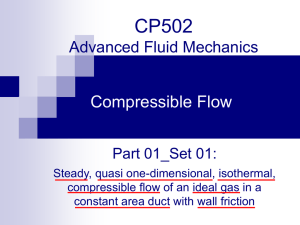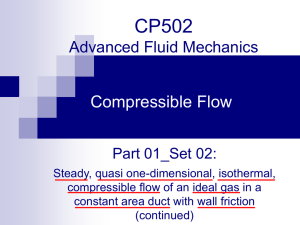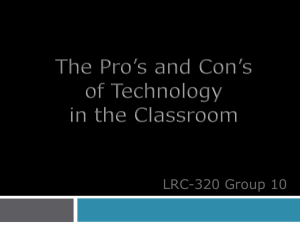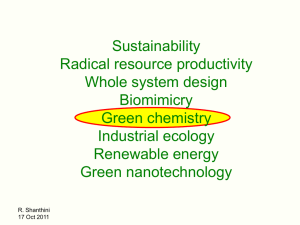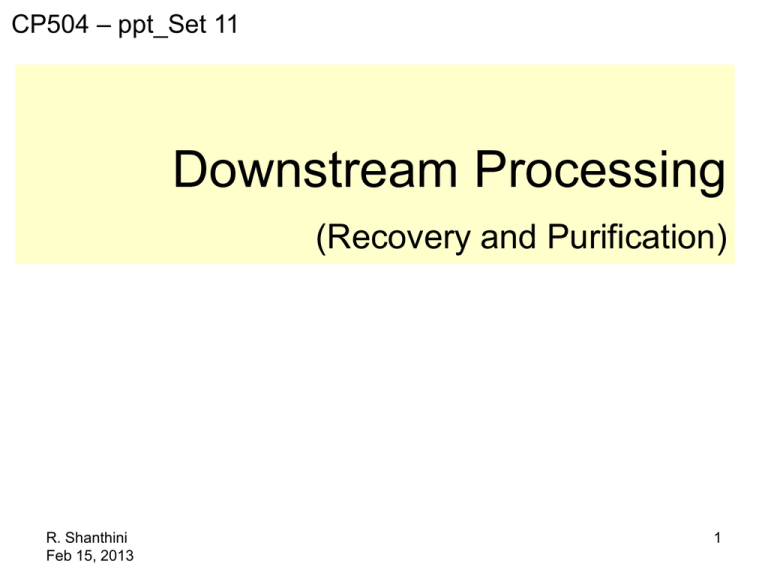
CP504 – ppt_Set 11
Downstream Processing
(Recovery and Purification)
R. Shanthini
Feb 15, 2013
1
SOURCE:
Bioprocess Design and Economics
by
Demetri Petrides, Ph.D.
President / INTELLIGEN, INC.
Email: dpetrides@intelligen.com
http://www.intelligen.com
An improved version of this document can be found in the following
textbook:
Bioseparations Science and Engineering
R.G. HARRISON, P.W. TODD, S.R. RUDGE and D. PETRIDES
http://www.oup-usa.org/isbn/0195123409.html
Oxford University Press, 2003
ISBN 0-19-512340-9
Copyright © 2000, by Demetri Petrides ALL RIGHTS RESERVED.
R. Shanthini
Feb 15, 2013
2
A few rules of thumb (or heuristics )
of a recovery and purification process:
1) Remove the most plentiful impurities first.
2) Remove the easiest-to-remove impurities first.
3) Make the most difficult and expensive separations last.
4) Select processes that make use of the greatest
differences in the properties of the product and its impurities.
5) Select and sequence processes that exploit different
separation driving forces.
R. Shanthini
Feb 15, 2013
3
R. Shanthini
Feb 15, 2013
4
R. Shanthini
Feb 15, 2013
5
R. Shanthini
Feb 15, 2013
6
Cell Harvesting:
– It is the first purification step for intracellular products.
– It is the removal of the extracellular liquid (which is in
agreement with the first general heuristic - remove the most
plentiful impurities first).
– Centrifugation and membrane separation/filtration (both
microfiltration and ultrafiltration) are the only techniques
used for large-scale cell harvesting.
R. Shanthini
Feb 15, 2013
7
Centrifugation in Cell Harvesting:
– Centrifugation has advantages for large and dense
microorganisms (diameter > 2 μm and density > 1.03 g/cm3).
– Ex: centrifugation is very efficient for harvesting yeast.
– For smaller microorganisms, various coagulation techniques
can be used to increase the size of the settling particles.
– Cell loss during centrifugation is typically 1 to 5%.
R. Shanthini
Feb 15, 2013
8
Membrane Separation in Cell Harvesting:
– Membrane separation has advantages for harvesting small
and light cells.
– Another advantage of membrane separation is in product
recovery.
– With membrane separation, essentially all cells are recovered
unless there is cell disruption (lysis) or ripped membranes.
R. Shanthini
Feb 15, 2013
9
R. Shanthini
Feb 15, 2013
10
Cell Disruption:
– Its purpose is to break open the host cells and release the
intracellular product.
– Disruption of bacteria and yeast is carried out either by
high pressure homogenizers or bead mills.
– Some protein degradation occurs during cell disruption due
to high shear and oxidation.
R. Shanthini
Feb 15, 2013
11
Homogenizer:
– It is a piece of laboratory equipment used for the
homogenization of various types of material (tissue, plant,
food, soil, and many others).
– The 'mortar and pestle' is also a homogenizer, and it is
used in modern laboratories.
– Modern homogenizer are based on blender type of
instruments (also known in the kitchen), bead mills, ultra
sonic treatment (also sonication), high pressure, and many
other physical forces.
R. Shanthini
Feb 15, 2013
12
Homogenizer:
– Older technologies focused on the disruption of the
material
– Newer technologies also address quality or environmental
aspects, such as cross-contamination, aerosols, risk of
infection, or noise.
R. Shanthini
Feb 15, 2013
13
High Pressure Homogenizer:
R. Shanthini
Feb 15, 2013
14
Bead Mills:
R. Shanthini
Feb 15, 2013
15
Osmotic Shock (or Osmotic Stress):
It is a sudden change in the solute concentration around
a cell, causing a rapid change in the movement of water
across its cell membrane.
Under conditions of high concentrations of either salts,
substrates or any solute in the supernatant, water is
drawn out of the cells through osmosis.
This also inhibits the
transport of substrates
and cofactors into the
cell thus “shocking” the
cell.
R. Shanthini
Feb 15, 2013
16
Osmotic Shock (or Osmotic Stress):
Alternatively, at low concentrations of solutes, water
enters the cell in large amounts, causing it to swell
and burst.
R. Shanthini
Feb 15, 2013
17
R. Shanthini
Feb 15, 2013
18
Removal of Cell Debris:
– The cell debris that is generated by cell disruption is usually
removed by centrifugation or microfiltration.
– Other options include rotary vacuum filtration, press
filtration, depth filtration, extraction, and expanded bed
adsorption (EBA) chromatography.
R. Shanthini
Feb 15, 2013
19
Soluble Product:
– When the product is soluble, it is recovered during cell
debris removal either in the light phase of a centrifuge or in
the permeate stream of a filter.
– Centrifuges efficiently separate only fairly large particles of
cell debris (greater than 0.5 µm Stokes’ diameter).
– Therefore, when a centrifuge is used for cell debris
removal, a polishing filtration step must follow to remove
small debris particles which might otherwise cause severe
problems in processes downstream such as chromatography.
– Various types of filters (e.g., depth, press, candle, rotary
vacuum, membrane microfilters, etc.) can be used for
polishing.
R. Shanthini
Feb 15, 2013
20
Insoluble Product:
– When the product is insoluble and forms inclusion bodies
(IBs), it must first be separated from the cell debris particles,
then dissolved and refolded (insulin is an example)
– Inclusion bodies usually have a large diameter (0.3 – 1.0
µm) and high density (1.3 – 1.5 g/cm3) and can be
separated from cell debris with a disk-stack centrifuge
– The inclusion bodies are recovered in the heavy phase of
the centrifuge while most cell debris particles remain in the
light phase.
– The heavy phase is usually resuspended and
recentrifuged 2-3 times to reach a high degree of inclusionbody purity.
R. Shanthini
Feb 15, 2013
21
Human Insulin Production:
Insulin facilitates the metabolism of carbohydrates and is
essential for the supply of energy to the cells of the body.
Carbohydrates, upon digestion, turn into a type of sugar
called glucose.
In the intestines, glucose is absorbed into the bloodstream.
Pancreas (a small gland located behind stomach) releases
insulin into the bloodstream.
Glucose and insulin travel along the bloodstream to the
cells.
Insulin acts like a key to unlock the cell so glucose can get
inside where it can be used for energy.
R. Shanthini
Feb 15, 2013
22
Human Insulin Production:
Impaired insulin production leads to the disease diabetes
mellitus, which is the third largest cause of death in
industrialized countries after cardiovascular diseases and
cancer.
R. Shanthini
Feb 15, 2013
23
Human Insulin Production:
Human insulin is a polypeptide consisting of 51 amino acids
arranged in two chains:
A consisting of 21 amino acids
B consisting of 30 amino acids.
The A and B chains are connected by two disulfide bonds.
Human insulin has a molecular weight of 5,734 and an
isoelectric point of 5.4.
R. Shanthini
Feb 15, 2013
24
Human Insulin Production:
Computer-generated
image of six insulin
molecules assembled in a
hexamer, with zinc ions
holding it together.
Insulin is stored in the
body as a hexamer, while
the active form is the
monomer.
R. Shanthini
Feb 15, 2013
25
Human Insulin Production:
Human insulin can be produced by four different methods:
1. Extraction from human pancreas (cannot be practiced due to
the limited availability of raw material)
2. Chemical synthesis via individual amino acids (technically
feasible; not economically viable due to the very low yield)
3. Conversion of pork insulin or “semisynthesis” (transforming
the porcine insulin (which differs only in one amino acid)
molecule into an exact replica of the human insulin molecule;
quite expensive)
4. Fermentation of genetically engineered microorganisms.
R. Shanthini
Feb 15, 2013
26
Fermentation of genetically engineered microorganisms :
Two-chain method:
This was the first successful technique of biosynthetic human
insulin (BHI) production based on recombinant DNA
technology.
Each insulin chain is produced as a β-galactosidase fusion
protein in Escherichia coli forming inclusion bodies.
The two peptide chains are recovered from the inclusion
bodies, purified, and combined to yield human insulin.
R. Shanthini
Feb 15, 2013
27
Fermentation of genetically engineered microorganisms :
Proinsulin method (intracellular):
Intact proinsulin is produced instead of the separate A and B
chains.
The E. coli cells overproduce Trp-LE'-Met-proinsulin in the
form of inclusion bodies, which are recovered and solubilized.
A number of chromatography and membrane filtration steps
are utilized to purify the product.
R. Shanthini
Feb 15, 2013
28
Fermentation of genetically engineered microorganisms :
Proinsulin method (secreted):
Yeast cells secrete insulin as a single-chain insulin precursor.
Secretion simplifies product isolation and purification.
The precursor contains the correct disulfide bridges and is
therefore identical to those of insulin.
It is converted to human insulin by transpeptidation in organic
solvent in the presence of a threonine ester and trypsin
followed by de-esterification.
Another advantage of this technology is the ability to reuse
the cells by employing a continuous bioreactor-cell separator
loop.
R. Shanthini
Feb 15, 2013
29
Proinsulin method (intracellular):
Fermentation media are prepared in a stainless steel tank
and sterilized in a continuous heat sterilizer.
A compressor and a filter provide sterile air and ammonia to
the fermentor.
A two-step seed fermentor train is used to inoculate the 50
m3 production fermentor with transformed E. coli cells.
These cells are used to produce the Trp-LE'-MET-proinsulin
precursor of insulin, which is retained in the cellular biomass.
The fermentation time in the production fermentor is about 18
hours, and the fermentation temperature is 37oC.
The final concentration of E. coli in the production fermentor
is about 30 g/liter (dry cell weight).
R. Shanthini
Feb 15, 2013
30
Proinsulin method (intracellular):
After the end of fermentation, the broth is transferred into a
surge tank.
Three disk stack centrifuges operating in parallel are used for
cell harvesting.
During centrifugation, the broth is concentrated from 37,000 L
to 9,165 L, and most of the extracellular impurities are
removed.
The cell recovery yield is 98%.
R. Shanthini
Feb 15, 2013
31
Proinsulin method (intracellular):
Next, a high pressure homogenizer is used to break the cells
and release the IBs.
The broth undergoes three passes under a pressure drop of
800 bar. The exit temperature is maintained at around 10oC.
The IB’s are recovered in the heavy phase (with a yield of
98%) while most of the cell debris particles remain in the light
phase.
R. Shanthini
Feb 15, 2013
32
Proinsulin method (intracellular):
All remaining fine particles (biomass, debris, and inclusion
bodies) are removed using a polishing dead-end filter.
This polishing filter protects the chromatographic units that are
used further downstream.
R. Shanthini
Feb 15, 2013
33
R. Shanthini
Feb 15, 2013
34
Final Purification Stages:
The final purification steps are dependent on the required
final product purity.
Pharmaceutical products require high purity.
Industrial products require lower purity.
For products of relatively low purity, such as detergent
enzymes, the final purification step is dehydration or
more generally a solvent removal step.
For high purity products, the final purification stages
usually involve a combination of chromatographic and
filtration steps.
If the final product is required in solid form, then, a
dehydration or solvent removal step follows.
R. Shanthini
Feb 15, 2013
35
Chromatography:
It is typically done later in a process in agreement with
the third generic heuristic, make the most difficult and
expensive separations last.
With the previous separation steps, a large fraction of
contaminants is removed, thereby reducing the volume of
material that needs to be treated further.
In fact, a 50-100 fold volumetric reduction is quite
common for high-value biological products, resulting in a
protein content of 1-5% w/v in the feed stream to
chromatographic units.
R. Shanthini
Feb 15, 2013
36
Chromatography:
More to come
R. Shanthini
Feb 15, 2013
37
Dehydration or Solvent Removal:
It is achieved with dryers.
Spray, fluid bed, and tray dryers are used when products
can withstand temperatures of 50-100oC.
Freeze dryers are used for products that degrade at high
temperatures.
Freeze dryers require high capital expenditures and should
be avoided if possible.
R. Shanthini
Feb 15, 2013
38
Membrane Separation:
R. Shanthini
Feb 15, 2013
No phase change
39
Ultrafiltration (UF):
UF is basically a pressure-driven separation process.
The operating pressure is usually between 0.1 and 1 MPa.
R. Shanthini
Feb 15, 2013
40
Ultrafiltration (UF):
UF is governed by a screening principle and dependent on
particle size.
UF membranes have a pore size between 1 nm and 100
nm (10 and 2000 Å), thus allowing retention of compounds
with a molecular weight of 300 to 500 000 Dalton.
Typically, the process is suitable for retaining biomolecules,
bacteria, viruses, polymers, colloidal particles and sugar
molecules.
R. Shanthini
Feb 15, 2013
41
Ultrafiltration:
R. Shanthini
Feb 15, 2013
42
dalton (Da):
The unified atomic mass unit (symbol: u) or dalton
(symbol: Da) is the standard unit that is used for
indicating mass on an atomic or molecular scale
(atomic mass).
It is defined as one twelfth of the mass of an unbound
neutral atom of carbon-12 in its nuclear and electronic
ground state.
1 Da = 1.660538921(73)×10−27 kg.
R. Shanthini
Feb 15, 2013
43
nanometre (nm):
The nanometre (nm) is often used to express
dimensions on an atomic scale.
Diameter of a helium atom = 0.1 nm
Visible light ranges from around 400 to 800 nm.
1 nm = 10 Å (angstrom)
R. Shanthini
Feb 15, 2013
44
Mathematical Model for Ultrafiltration:
Mechanism: selective filtration through the pores
Rejection of the membrane for a given compound is
dependent on the molecular weight of the compound, its
shape, size, and flexibility, as well as the working conditions.
R. Shanthini
Feb 15, 2013
45

